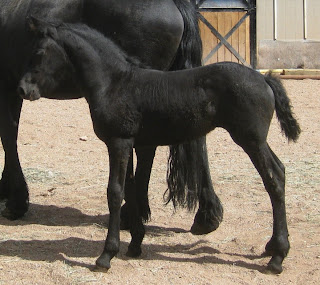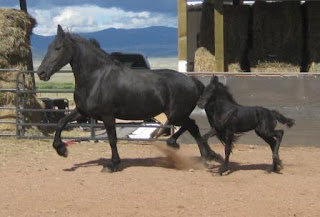Quality semen
Fertility rate is the best indication of sperm quality. Many factors affect the quality of semen. Stallion physical health, nutrition, frequency of collection and diseases can affect the quality. How the semen is handled post collection is very important. Maintenance of temperature, frozen or chilled is very important. Semen can usually only last 24-48 hours chilled. If it’s frozen it can last forever, but if it’s thawed slightly it will affect it’s viability. Progressive Motility is not an indication of fertility, however it is an indication of the health of the semen, if nothing is swimming forward, nothing will get to the egg. Fertility rate is truly your best indication of healthy sperm.
Frozen
No all stallions produce the same quality semen. Some can be frozen and some can’t. If you are picking a stallion that is not in the same country as your mare you will be limited to Frozen semen. There are sometimes decreased fertility rates with Frozen and some mares don’t conceive well with Frozen semen. Frozen semen on average will have a lower Progressive Motility than chilled, but remember PM is not an indication of quality.
As a whole Frozen semen is a great opportunity to increase the DNA variation of your offspring and the population, and to have sperm on hand exactly when you need it. When it’s stored on site it can be thawed out right when your mare ovulates and you don’t have to wait on stallion collection schedules and shipping. There are many people that sell and import Frozen semen, but be careful who you buy it from. How the semen is handled affects it’s thaw motility, so it’s important that it’s handled correctly at collection, transport, storage, and thaw and insemination.
Some people sell Frozen semen from stallions that have low fertility with frozen semen. Frozen semen usually doesn’t come with a guarantee of fertility, motility or a live foal guarantee. Questions to ask the seller is if they have ever tested the semen either under a microscope or by breeding mares, find out what their success rate was with the semen. Find out if they have been trained professionally to handle frozen semen, and where it’s been stored.
We have frozen semen available for Fabe, Dries, Bente, Gjalt
http://sableranch.net/frozensemen.html, all of our semen was tested under a microscope or on mares. I’ve been trained by Colorado State University in Handling Frozen Semen. We are happy to help you with your frozen semen needs.
Chilled Semen
This is the most common method when using stallions that are in the same country as the mare. Some stallion owners provide frozen and chilled but chilled is the most common.
The fertility with chilled depends on several factors. The stallion health, collection method, The extender, the travel time to get to the mare, how the mare reacts to the extender, and more. You will not have much control over the stallion handling prior to shipping but you will what to make sure that the semen is shipped to you with next day delivery. The faster the semen gets from the mare to the stallion the better. Stallions are usually collected on a schedule so know that schedule. If they only collect Monday, Wednesday, Friday you will only have semen on Tuesday, Thursday and Saturday. Saturday delivery may not be available in your area so be aware of the schedules. So when you are getting your mare ultrasounded you need to account for collection schedule, shipping time, and ovulation estimation.
Fresh
With fresh your mare and stallion have to be in the same location. It’s still recommended to artificially inseminate (AI) even with the two of them in the same location. The reason to AI is to avoid having the mare kick the stallion, the stallion bite the mare, added weight on the mares hips, and the most important… Diseases. There are many diseases that can be transferred from mare to stallion and stallion to mare. If you choose to live cover there are some things you can do to protect both the stallion and mare. Check to make sure the mare is actually in heat and receptive to the stallion. It’s amazing how angry a mare can get towards a stallion when she is actually not in heat. Secondly you should wrap the mares tail so that the hairs don’t cut the stallion or get pulled into the process. Also there are breeding hobbles that can restrict the mare from getting a good kick at the stallion. They are not fool proof and they are not a guarantee of no kicking but they might help. Also if your mare has never worn them before you should test them out prior to introducing the stallion so there are no surprises.
If your mare has less than desirable results have your semen checked by a veterinarian. You can also ask if the stallion had any infections or illnesses in the past few months, or if there are other people having the same problem conceiving. Also have your mare checked for infection, thyroid deficiency, allergic reactions to the extenders, ect. Not all breeding problems are the stallions fault, the mare contributes her fair share of problems also. (See the Thyroid Blog, Infection blog, mare uterine exam blog)





.jpg)












